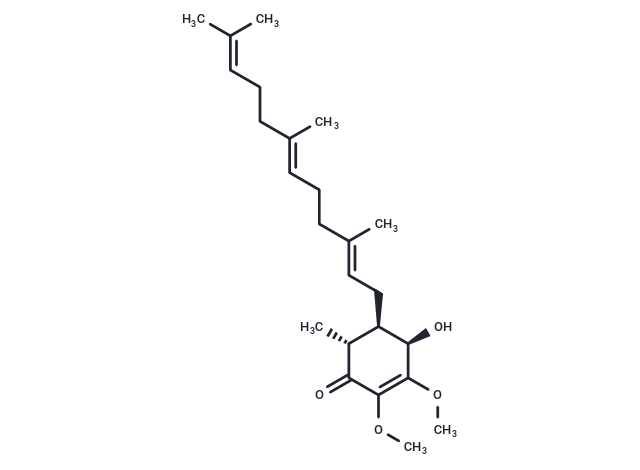Shopping Cart
- Remove All
 Your shopping cart is currently empty
Your shopping cart is currently empty

Antroquinonol is a ubiquinone derivative from Antrodia camphorata with anti-inflammatory and anticancer activities.Antroquinonol reduces oxidative stress and inhibits inflammation and sclerosis in mice with focal segmental glomerulosclerosis through enhancement of the Nrf2 signaling pathway.Antroquinonol has potential for use in the treatment of non-small cell lung cancer. Antroquinonol has potential for the treatment of non-small cell lung cancer and may be used in colon cancer research.

| Pack Size | Price | Availability | Quantity |
|---|---|---|---|
| 1 mg | $662 | In Stock | |
| 5 mg | $1,530 | In Stock | |
| 10 mg | $2,150 | In Stock | |
| 25 mg | $3,290 | In Stock |
| Description | Antroquinonol is a ubiquinone derivative from Antrodia camphorata with anti-inflammatory and anticancer activities.Antroquinonol reduces oxidative stress and inhibits inflammation and sclerosis in mice with focal segmental glomerulosclerosis through enhancement of the Nrf2 signaling pathway.Antroquinonol has potential for use in the treatment of non-small cell lung cancer. Antroquinonol has potential for the treatment of non-small cell lung cancer and may be used in colon cancer research. |
| In vitro | Antroquinonol at high concentrations (40-80 μM; 24h) exhibits growth inhibitory activities in the human HCT15, HCT116, and LoVo colon cancer cell lines, whereas low concentrations of Antroquinonol (2.5-20 μM; 24h) show modest growth inhibition. The GI50s on HCT15 and LoVo cells were 34.8±0.07 and 17.9±0.07 μM, and the GI50 on HCT116 cells was >80 μM.[2] Antroquinonol possesses the ability to inhibit breast cancer migration/invasion by inhibiting the EMT and MMP-9 gene expression.[2] Antroquinonol has inducible nitric oxide synthase (iNOS) inhibitory activity in lipopolysaccharide (LPS)-activated macrophages, anti-inflammatory activity in macrophage cell cultures by reducing the production of tumor necrosis factor-α and interleukin (IL)-1β, and anti-cancer activity against hepatoma cells.[3] |
| In vivo | Antroquinonol (50 mg/kg; gavage; daily; 21 days; female BALB/c mice) ameliorates proteinuria, improves renal function, and decreases renal lesions, including EPHL, a severe index of glomerular injury, in FSGS mice. Disease-control FSGS mice treated with vehicle showed increased urine protein levels from day 7 after induction of FSGS that continued to increase to the end of the study at day 21. This effect was almost completely suppressed in FSGS mice treated with Antroquinonol, their levels being similar to those in normal control mice.[3] |
| Molecular Weight | 390.56 |
| Formula | C24H38O4 |
| Cas No. | 1010081-09-0 |
| Smiles | C(/C=C(/CC/C=C(/CCC=C(C)C)\C)\C)[C@H]1[C@@H](O)C(OC)=C(OC)C(=O)[C@@H]1C |
| Relative Density. | 1.01 g/cm3 (Predicted) |
| Storage | store at low temperature,keep away from direct sunlight | Powder: -20°C for 3 years | In solvent: -80°C for 1 year | Shipping with blue ice. |

Copyright © 2015-2025 TargetMol Chemicals Inc. All Rights Reserved.